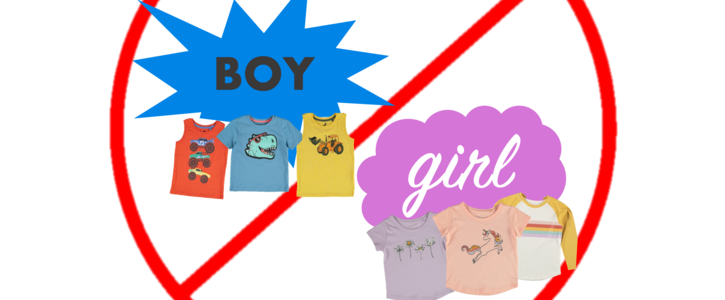1,000 signatures reached
To: Kmart Australia
Kmart: Replace the "boys" and "girls" clothing sections with an inclusive kids' section

It's time to stop classifying children’s clothing by gender.
Replace this with one kids’ clothing section, organised by type (e.g. skirts in one area, jeans in another, t shirts in a third, etc.).
Replace this with one kids’ clothing section, organised by type (e.g. skirts in one area, jeans in another, t shirts in a third, etc.).
Why is this important?
Young children are told which colours, clothing styles and even interests they are permitted to have through the choices they have available in their respective gender’s clothing department.
Many parents of young boys will tell you their son loves pink, rainbows and flowers but simply cannot wear clothes in these styles like girls do without taking them from the girls’ section, which sends them a strong message that the things they like are “wrong”. Similarly, many parents of girls lament the lack of dinosaurs, trucks, and non-frilly styles in the girls’ section.
This is a problem that has already been addressed by many smaller and independent retailers, who have done away with “girls” and “boys” sections entirely, in favour of an inclusive children’s one. It is time for Australia’s biggest retailers to follow suit.
Nobody really believes that boys’ interests are limited to cars, diggers, dinosaurs and sharks.
Nobody honestly thinks girls only like rainbows, flowers, unicorns and ice cream.
Nobody reasonably considers certain colours to belong exclusively to a certain gender.
Enough. Get rid of the gender separated clothing sections, and let kids choose exactly what they like without arbitrary boundaries.
_________________________
FREQUENTLY ASKED QUESTIONS
***Why can’t you just pull things from the opposite section?***
Firstly, that’s not always possible. Cut and style are issues (consider e.g. a boy who wants a colour or pattern from the girls’ section but doesn’t want the fitted cut).
More importantly, having the clothes separated in the first place sends a strong message to kids that there is an appropriate or a “normal” way for them to dress based on their gender. Any child who wants to wear something from the “other” section gets a strong message that their desire is, at the very least, “weird”, and at worst, straight-out wrong.
We can’t expect a young child to overcome these arbitrary barriers on their own. If we truly believe that it’s OK for boys to wear pink, and for girls to like cars and trucks, then let’s do away with two sections and let them pick exactly what they like.
***But sizing for boys and girls is different!***
What many refer to as “sizing” is really a difference in the style and cut of clothes. There is no difference at all in sizing for young children (in fact, designers use one form/mannequin for girls and boys). As they get older, children’s bodies change shape - but they change as much from each other as they do from those of the “other” gender. We are all very different from each other in our body sizes and shapes, which is why sometimes we struggle to find things that fit even though it is made for our gender. When clothes are sorted by style (e.g. fitted t shirts on one rack; box cut on another), and then by size, there is no issue in sizing at all. Consider the multitude of unisex kids’ and adults’ clothing companies (a quick google will return lots of them), who have no trouble with sizing.
***Won’t it be hard to find what I want to buy?***
Not at all! Clothing is organised by type, then by style or colour. Some shops already organise their clothes this way. So do a ton of online retailers of kids' clothing. We already organise toys by type, which used to be separated by gender.
***What do other parents think?***
Since this campaign began, parents have shared many examples of times they were frustrated with the kids' clothing options available in store - from a toddler's hat with a whale on it labelled "boys' hat", to the lack of bright colours in the boys' section, to the lack of practical, durable clothing in the girls'.
***I just want more variety; I don’t want to put both sections together.***
We agree that more variety in children’s clothing is absolutely needed generally. That is part and parcel of this campaign. Having two sections is a bit of a self-perpetuating gender loop - before designers even begin they have to choose if they're designing for the "girls" or "boys" section, which immediately limits their options and makes it more likely for them to "over-gender" the clothes. If we unify the sections we are encouraging much more variety in children’s clothes generally, and on the way we’re taking down any barriers that might cause a child to feel “wrong” for wanting clothes that previously “belonged” to the other gender. Win-win!
***Isn't it natural for girls to like e.g. pink and boys to like e.g. blue?***
No, it isn't. A hundred years ago it was the exact opposite - pink was considered "robust" and suitable for boys, and blue "softer" and appropriate for girls. Before that, parents dressed all young children in dresses - it was considered distasteful to gender them with clothing as this brought attention to their sexuality at such a young age.
This all began to change in the middle of the 20th Century, largely as a reaction to male homosexuality. People believed that dressing boys like "little men" would stop homosexuality. Ha!
In any case, we know that girls are not born with a love for glitter and unicorns. Similarly, infant boys show no aversion to pink, and no preference for dinosaurs over bunny rabbits. It's all made up. Why don't we let them have exactly what they like - glittery, neutral, bunnies or bulldozers?
Many parents of young boys will tell you their son loves pink, rainbows and flowers but simply cannot wear clothes in these styles like girls do without taking them from the girls’ section, which sends them a strong message that the things they like are “wrong”. Similarly, many parents of girls lament the lack of dinosaurs, trucks, and non-frilly styles in the girls’ section.
This is a problem that has already been addressed by many smaller and independent retailers, who have done away with “girls” and “boys” sections entirely, in favour of an inclusive children’s one. It is time for Australia’s biggest retailers to follow suit.
Nobody really believes that boys’ interests are limited to cars, diggers, dinosaurs and sharks.
Nobody honestly thinks girls only like rainbows, flowers, unicorns and ice cream.
Nobody reasonably considers certain colours to belong exclusively to a certain gender.
Enough. Get rid of the gender separated clothing sections, and let kids choose exactly what they like without arbitrary boundaries.
_________________________
FREQUENTLY ASKED QUESTIONS
***Why can’t you just pull things from the opposite section?***
Firstly, that’s not always possible. Cut and style are issues (consider e.g. a boy who wants a colour or pattern from the girls’ section but doesn’t want the fitted cut).
More importantly, having the clothes separated in the first place sends a strong message to kids that there is an appropriate or a “normal” way for them to dress based on their gender. Any child who wants to wear something from the “other” section gets a strong message that their desire is, at the very least, “weird”, and at worst, straight-out wrong.
We can’t expect a young child to overcome these arbitrary barriers on their own. If we truly believe that it’s OK for boys to wear pink, and for girls to like cars and trucks, then let’s do away with two sections and let them pick exactly what they like.
***But sizing for boys and girls is different!***
What many refer to as “sizing” is really a difference in the style and cut of clothes. There is no difference at all in sizing for young children (in fact, designers use one form/mannequin for girls and boys). As they get older, children’s bodies change shape - but they change as much from each other as they do from those of the “other” gender. We are all very different from each other in our body sizes and shapes, which is why sometimes we struggle to find things that fit even though it is made for our gender. When clothes are sorted by style (e.g. fitted t shirts on one rack; box cut on another), and then by size, there is no issue in sizing at all. Consider the multitude of unisex kids’ and adults’ clothing companies (a quick google will return lots of them), who have no trouble with sizing.
***Won’t it be hard to find what I want to buy?***
Not at all! Clothing is organised by type, then by style or colour. Some shops already organise their clothes this way. So do a ton of online retailers of kids' clothing. We already organise toys by type, which used to be separated by gender.
***What do other parents think?***
Since this campaign began, parents have shared many examples of times they were frustrated with the kids' clothing options available in store - from a toddler's hat with a whale on it labelled "boys' hat", to the lack of bright colours in the boys' section, to the lack of practical, durable clothing in the girls'.
***I just want more variety; I don’t want to put both sections together.***
We agree that more variety in children’s clothing is absolutely needed generally. That is part and parcel of this campaign. Having two sections is a bit of a self-perpetuating gender loop - before designers even begin they have to choose if they're designing for the "girls" or "boys" section, which immediately limits their options and makes it more likely for them to "over-gender" the clothes. If we unify the sections we are encouraging much more variety in children’s clothes generally, and on the way we’re taking down any barriers that might cause a child to feel “wrong” for wanting clothes that previously “belonged” to the other gender. Win-win!
***Isn't it natural for girls to like e.g. pink and boys to like e.g. blue?***
No, it isn't. A hundred years ago it was the exact opposite - pink was considered "robust" and suitable for boys, and blue "softer" and appropriate for girls. Before that, parents dressed all young children in dresses - it was considered distasteful to gender them with clothing as this brought attention to their sexuality at such a young age.
This all began to change in the middle of the 20th Century, largely as a reaction to male homosexuality. People believed that dressing boys like "little men" would stop homosexuality. Ha!
In any case, we know that girls are not born with a love for glitter and unicorns. Similarly, infant boys show no aversion to pink, and no preference for dinosaurs over bunny rabbits. It's all made up. Why don't we let them have exactly what they like - glittery, neutral, bunnies or bulldozers?
